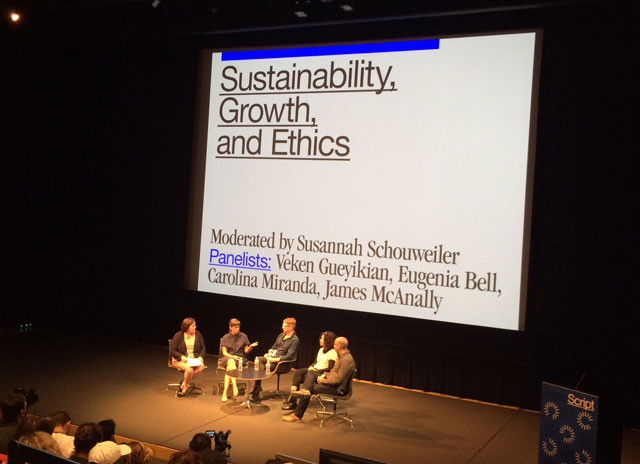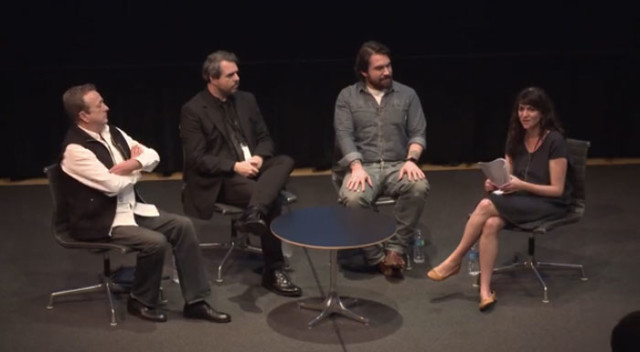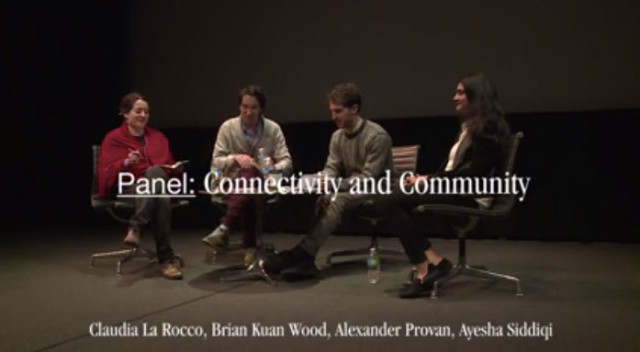
Claus Oldenburg and Coosje van Bruggen outside The Walker Art Center
I’ve been thinking a lot about community lately. There are a number of reasons for this, but most recently it’s that I spent last Friday and Saturday in Minneapolis contemplating the state of online art criticism with some two hundred other journalists. During the Walker Art Center’s digital art criticism conference, Superscript, no Twitter brawls broke out. No screaming arguments over Jeff Koons took place. Pretty much everyone got along.
In fact, anyone I spoke to wanted to share their experiences and knowledge. In the world of arts journalism that’s a big deal. Nobody’s hiding secrets, exactly, but if there’s one thing Superscript made clear, it’s that the advent of email, Facebook, and Twitter doesn’t mean we’re talking to each other. There’s so much we don’t know about other publications, from each other’s publishing ethics to what we pay and get paid.
Two days is just enough time to scratch the surface on some of these issues. To do this, Walker organizers Paul Schmelzer and Susannah Schouweiler, brought in independent- and mainstream-media arts writers from across the country to talk about how this changing world shapes what we do and who we are. This took the form of two panels per day—four panelists per subject presenting for 15 to 20 minutes each, plus a film screening, and a keynote.
There’s not much to say about the keynotes—James Bridle delivered an artist talk while Ben Davis ran through the history of image reproduction in reviews—but I had a lot of opinions about the talks. Those thoughts below.

Sustainability for art writing
1. Very few of us know much about the publishing business. Everyone is unhappy with the pay.
Panel: Sustainability, Growth & Ethics
Susannah Schouweiler (moderator) editor-in-chief of MN Artists
Veken Gueyikian, publisher of Hyperallergic
Eugenia Bell, executive editor at the Design Observer
Carolina Miranda, staff writer for the Los Angeles Times
James McAnally co-founder of Temporary Art Review
Panel (Moderated by Susannah Schouweiler)Watch the panel here.
Talk about an eye-opening panel discussion. Carolina Miranda dedicated her speech to discussing how to make a living as a freelancer. The take-home: don’t give your work away for free and a living wage for a writer is $1 per word.
This seemed like pie-in-the-sky rates to many writers in the audience; it never even came up that this was at the low-end of price points a few years ago. More shock, though, came with the revelation that standard pay for blogs clocks in at $50 per post. We never even got into salaries.
It was a little disconcerting to see so many writers so unaware of the financial realities of their own work, so it seemed like a missed opportunity that the panel didn’t include more professionals who had dealt with this successfully. Where was Patricia Maloney of Art Practical and Daily Serving? These publications are now published by the California College of Arts, which has given them a world of new opportunities and funding sources.
It also might have been nice to see someone from Artforum or Art in America on the stage, as both publications were cited as having problematic editorial policies in previous discussions. Advertising not only dictates whether a gallery gets a review, but whether stories are positive or negative. (Earlier that day Los Angeles Times critic Christopher Knight told a story of how his cover story was entirely rewritten because it was not deemed positive enough.)
As such, the real heroes of this lecture were the Hyperallergic team, as represented by publisher Veken Gueyikian. He told the story of Hyperallergic’s rise and business strategy. That presentation involved lots of graphics and post examples, but long story short, the publication suffers from no editorial conflict because they sell marketing to advertisers, not PR. (In other words, the ad network sells their readership to advertisers not reviews. As a result galleries place ads less frequently.) The Nectar Ads network supports a host of blogs, including Art F City, providing independent publishers with an income they would not have otherwise. In a publishing world dominated by magazines owned by Russian oligarchs and mega-collectors, it’s hard to understate what an accomplishment this is: up until now, every trade magazine subsisted on PR advertising or starved.
Gueyikian told audiences that Hyperallergic brings in over one-million views per month from across the globe, and within the insular art world that’s nothing short of a massive success. I left feeling elated.

Credibility, Criticism, Collusion: Christopher Knight, Ryan Schreiber, Isaac Fitzgerald and Orit Gat
2. No definition of successful critics and criticism.
Panel: Credibility, Criticism, Collusion
Ryan Schreiber, founder and CEO, Pitchfork
Orit Gat, managing editor, WdW Review, contributor, Rhizome
Christopher Knight, art critic Los Angeles Times
Isaac Fitzgerald, books editor, BuzzFeed Books
Panel (Moderated by Orit Gat). Watch the panel here.
This panel was all over the place. Speakers considered the role of criticism, conflicts of interest, and negative criticism—all topics that seem to relate to each other—except when these panelists got together. The conversation flitted from criticism 101 topics like why a critic should never fear announcing their presence at a dinner party to whether their role in the art world was to keep the market in check. (Moderator Orit Gat afforded critics an outsized effect on sales.)
Nevertheless two stars emerged: Los Angeles Times critic Christopher who declared that in the body of art, criticism was the appendix. Remove it, and there will be no appreciable difference. No definition of good criticism needed, I guess, because the whole field is irrelevant. And the ad hock presentation of Buzzfeed Editor Isaac Fitzgerald, who traced his career history, only to trip over a recent memory of an interview where he offered prescriptive advice as opposed to personal insight. The remarks, “If you can’t say something nice, don’t say nothing at all,” spiraled into a full blown PR disaster that ended with him in his bathtub, fully clothed and wallowing in misery. Many people believed Buzzfeed Books should offer criticism.
Two years later, Fitzgerald is still licking his wounds from that misstep, but maintains his position as a fan more than a critic. Even with his presence, though, the discussion often focused on negative criticism without much balance. For example,WdW Review‘s Orit Gat zeroed in on reviews that go viral—Pete Wells’s all-question review of Guy Fieri’s restaurant got more than one nod—but at the expense of the critic’s larger body of work. Like most successful mainstream critics, Wells consistently errs on the side of generosity. (Even the Fieri review will seem so to those who have dined there.) That’s probably not a bad thing—when tens of thousands read your work it’s best to be cautious—but it also means that those restaurants, galleries, and movies in need of more substantial criticism sometimes go without. More significant reflection on what constitutes successful criticism was needed.
This panel was also the place where another female voice was most needed. White male authority is dominant enough as it is—an all-male critic panel with a female moderator only re-enforces those biases.

Connectivity and Community
3. Critics are sometimes short on solutions.
Panel: Connectivity & Community
Claudia La Rocco, founding editor, Performance Club
Ayesha Siddiqi, staff writer, The New Criterion
Alexander Provan, founding editor, Triple Canopy
Brian Kuan Wood, founding editor, e-flux
Panel (Moderated by Claudia La Rocco). Watch the panel here.
Undoubtedly the best and worst of the conference all in one. On the one hand we had the fucking incredible: near-poetry delivered by Claudia La Rocco, on what amounted to her life story as a critic. In one of of many memorable anecdotes she describes her reaction to a request from the Warhol Foundation asking for traffic stats. “How do you explain that you jumped the entire concept of the ‘book club for live art’ in favor of building a space for criticism of art with weird little chunks of writing that most people will have zero interest in? Is there a way to say that the island of misfit toys suits you more than the island of inclusivity?” I’ve felt all of this at different times, but could never articulate it so well. I actually got shivers.
That was followed by near tears as I listened to Ayesha Siddiqi speak. “Visibility in a surveillance state is not power,” Siddiqi remarked in a talk about the politics of social media. Social capital doesn’t give people actual capital. Our labor on social media is free and exploited. We don’t own what we produce. Minorities are more frequently harassed. The closing of Siddiqi’s speech, which called for a recognition of these problems and intervention caused a near eruption of applause.
Had the talks ended there, I would have been happy. Triple Canopy’s Alex Provan used his presentation to parse the distinction between a community and the public. According to Provan, Triple Canopy isn’t interested in a community which is about “boundaries.” The “public,” on the other hand, is great because it’s “strangers who choose to join one another through discourse.” After hearing Siddiqi speak, this kind of parsing read as little more than navel-gazing. If I wanted to learn anything about Triple Canopy, the publication, this talk told me nothing.
E-flux’s presentation wasn’t very good either—it was Brian Kuan Wood talking about how thrilling it was to have a comment community—but the larger issue was the panel. Speakers narrowed into negative thinking without offering any solutions to the problems they identified. At one point, Siddiqi even compared the social media culture that says “if I can see it, I’m allowed to take it” to rape culture. I have to assume Siddiqi would take back this comment if pressed—God forbid there were any rape victims in the audience.

Claire Evans gives a talk on science fiction and Terraform at Motherboard
4. “Visionaries” and “first responders” are not the same thing.
Panel: Artists as First Responders
Marisa Mazria-Katz, editor Creative Time Reports
Dan Fox, co-editor, Frieze Magazine
Claire Evans, singer and co-author of the band Yacht, futures editor at Motherboard
Panel (Moderated by curator Fionn Meade; includes artist James Bridle). Watch the panel here.
The only panel I have almost nothing to say about, perhaps because its title, “Artists as First Responders” espouses a fiction. Artists aren’t the best first responders—the art world is better for analysis and reflection—but also the entire topic seemed a little out of place in a conference about journalism.
Dan Fox brought the language problem up in his talk, but the strongest presentation did, actually, make a case for artists as first responders—or more accurately, “visionaries.” Claire Evans, a musician and writer of Terraform, spoke about how the blog commissions journalists to write science-fiction stories about their beats. The results sound amazing. Technology writer Paul Ford imagined a dystopia in which Uber controls all resources. Music and internet-culture blogger Carles painted a 2065 version of Coachella: 50 years in the future it is a militarized tent city in a sun-baked desert.
These aren’t answers to our problems—they’re more like worst-case scenarios—but they encourage us to imagine different and better worlds. As Evans rightly concluded: “I think that now, more than ever, science fiction has a responsibility to be engaged head on with the complexities of the world because, frankly, we need it, as a critical tool.”
And if there’s anything I’d like to see in the next iteration of Superscript, it’s a greater emphasis on producing solutions—not just identifying problems. As a group, our skills have certainly been honed to do as much. Though the discussion of how the internet has affected online criticism proved fairly light that weekend, my own feeling is that it has forced art critics to think more creatively. Perhaps evidencing this shift earlier in the weekend, Hyperallergic’s Hrag Vartanian casually observed that many writers in attendance describe themselves as artists. And those who didn’t could easily have donned the title; Carolina Miranda used Medieval illuminations to illustrate her lecture on surviving the freelance world.
The fact is, the most successful bloggers are constantly thinking creatively on their feet. The best (and often most painful) bi-product of the internet, is that the speed and volume requirements of online publishing forces a writer to suffer through self doubt and simply throw their ideas out there. That’s obviously got its pluses and minuses, but for many writers, it’s the difference between producing tomes and nothing at all.


Comments on this entry are closed.
{ 1 trackback }